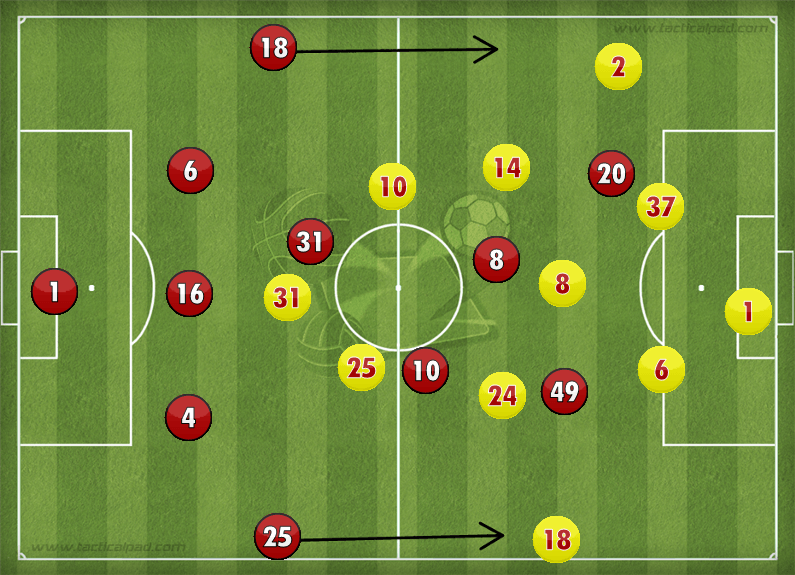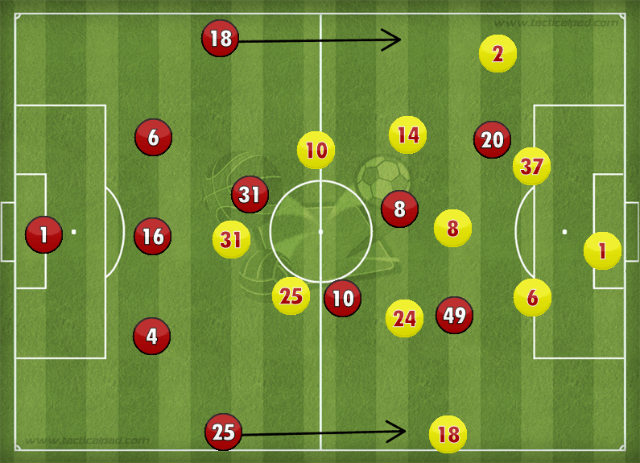There were times where this fixtures involved two of the most in form teams in England, and there were occasions where the gulf in class was evident. But the first Manchester United-Liverpool clash of 2014/15, had a slightly altered flavour to it. Two sides fallen from their respective perches, some longer than others, looking to recover before the stagnation persists. Despite the score-line, neither side truly impressed but even if there’s a lack of performance, United showed they haven’t forgotten how to win football matches.

Manchester United: 1. De Gea // 25. Valencia – 4. Jones – 16. Carrick – 6. Evans – 18. Young // 31. Fellaini – 10. Rooney – 8. Mata // 49. Wilson – 20. Van Persie
Liverpool: 1. Jones // 2. Johnson – 37. Skrtel – 6. Lovren – 18. Moreno // 8. Gerrard – 24. Allen – 14. Henderson // 25. Lallana – 10. Coutinho – 31. Sterling
Goals: Rooney 12′, Mata 40′, Van Persie 71′
Liverpool’s change in attacking approach inadvertently reduces pressure on Man United’s defensive strategy
Brendan Rodgers surprised many with his team selection, right from replacing the first-choice goalkeeper to going with no natural striker in the side. It wasn’t an approach that Louis Van Gaal could have prepared for given that it left most astounded (unless the United boss goes through Twitter and depends on team leaks). So the idea the 63-year-old would have set out with was to go by what Rodgers had gone in with for the past couple of weeks (which has been a stubbornly identical approach to the previous games, without much alterations). With Van Gaal someone who does his homework, he would have anticipated a lone striker, two wide men and Steven Gerrard behind them. His response was to organise a three man defensive line and two wing-backs against the 3+1 attack of Liverpool which has thus far struggled against a four man defence, plus a strong defensive midfielder in Marouane Fellaini to keep the Liverpool captain in check.
Liverpool however opted for a more fluid trio in attack with Raheem Sterling, Adam Lallana and Phillipe Coutinho; behind them was a three man central midfield line. So while Van Gaal went in with the idea of containing Liverpool’s usual approach, he was faced with a new one which in hindsight played right into Man United’s hands.

Liverpool failed to take advantage of the gaps left behind and in fact facilitated the United wing-backs moving forward
While Liverpool have thus far relied on more of a wide approach from the men who flank the central striker, against United they (Lallana and Coutinho) played a more narrow game. While this did allow an improvement in attack for the away side, it failed to harm United’s defence and instead added to their attack; because with Liverpool three front men playing narrow, it created a three-vs-three situation with United’s defenders. It was an intriguing battle as Liverpool did have a couple of chances, but were largely kept well under control by United’s defence and David De Gea (when the defence was breached). This three-vs-three in a narrow sense reduced the defensive burden on Manchester United’s wide defenders, Ashley Young and Antonio Valencia, and created an opportunity for them to regularly join up wide in attack. The home sides’ first goal was created purely by Antonio Valencia, free from defensive duty, and their second by Ashley Young.
Liverpool’s change in approach also significantly reduced any pressure on Marouane Fellaini. In the side to primarily deal with Steven Gerrard and his potential attacking bursts, he was instead required to now deal with Lallana, Coutinho and Sterling – all players who he can physically handle with much ease. Credit here to Wayne Rooney too who continued to play deeper than he has previously in his career, assisting Fellaini defensively when over-burdened but significantly for his own good having less pressure on himself and thus able to influence attack more (Liverpool didn’t seem to have a specific plan to contain Rooney; no man on him, no real defensive midfielder, nothing).

So when Van Gaal thought out his plan the day before the game, he envisioned possibly Lambert/Balotelli being handled by a three man defence; two wide men being handled by Young and Valencia and Fellaini keeping Gerrard in check (and any narrow movement from Liverpool’s wide men). What he got instead was far more suited to his approach – defensively Manchester United’s three man defence were made to deal with Liverpool’s three man attack, aided by an extra body in Fellaini. Those wide men didn’t have wide defensive duties which only increased their attacking contribution. Though this is not to say Valencia and Young didn’t defend; they were in position to form a five man defence when needed, without too much pressure as Liverpool had nothing from wider areas besides occasional bursts from Jordan Henderson on the right and Alberto Moreno on the left. Glen Johnson’s injury also further reduced chances of an attack from wider areas so the five man defence was in fact just another added cushion to prevent the narrow approach Liverpool were trying.
Interestingly, had Rodgers gone with his more typical use of a natural strong centre forward and Gerrard behind him, he would have found more joy despite Van Gaal’s preparations for exactly that. Once Mario Balotelli was brought on as that imposing figure, Sterling/Coutinho began playing behind him a bit more. It pressurised United’s defence, gave Fellaini more to do and the team in yellow genuinely looked like scoring, but for De Gea.
Manchester United’s make-shift men
Two natural defenders were named in the Manchester United side as Phil Jones and Jonny Evans seemed like they’d have tons of pressure on themselves. Instead, Michael Carrick was thrown centrally into the defensive line, and as has been the case over recent weeks, wingers in Ashley Young and Antonio Valencia at full-back.
As touched upon previously, Young & Valencia who were in the side to contain wide attacking pressure had none come their way and thus had more to give in attack. While aided by that lack of wide attack from Liverpool, they were further allowed to contribute to the attacking phase by Liverpool’s poor defensive cover out-wide. Neither Jordan Henderson & Joe Allen did enough to cover wide areas on either side of Steven Gerrard (who himself had nothing in attack or defence), instead pre-occupied with containing Juan Mata & Wayne Rooney centrally along-with the occasionally retreating James Wilson and Robin Van Persie. The defensive onus out wide for Liverpool was purely on the full-back, who further disappointed.
Alberto Moreno had a shocker of a game, often far too wide for his own good, disconnected from his defenders and allowing Valencia to push-forward far too easily. The first goal came as a result of this, and there were plenty of situations as the game wore on that saw Valencia in acres of space. Moreno seemed to be prone to over-committing out wide and getting beaten, or staying too narrow and further allowing the Ecuadorian to play; he failed to strike that balance between attack-defence, and moving out wide or staying narrow.

On the other side, Glen Johnson’s injury meant Kolo Toure was brought in to create a strange bit of a back line. Moreno was often too wide, and Kolo Toure too narrow. So it formed a weird sort of 3 + 1 defensive line for Liverpool, showing a clear imbalance. Ashley Young didn’t find as much space as Valencia on the other side (owing to a naturally central defensive Toure playing at right-back), but he had enough opportunities to take his time and cut onto his right like he so often does, producing the second.
But the undoubtedly stand-out make-shift performer was Michael Carrick. While he has thus far this season been as poor a defensive midfielder as Steven Gerrard has for Liverpool, failing to follow runners, win second balls and generally showcasing a lack of intelligence for the role, he was made to play right at the heart of the defence with fantastic results. One might even say Michael Carrick would make for a far better central defender (ONLY with two other ones on either side), than he does a defensive midfielder. While the latter role requires that positional intelligence, the lack of which can leave the defence vulnerable, the former role would require more in terms of staying put.
The fact that Liverpool didn’t play a natural powerful striker but a more fluid Sterling made Carrick’s job that much more easier. A fluid Sterling meant little in terms of direct penetration, with the 20-year-old instead causing more trouble to Jones & Evans. Balotelli’s introduction no doubt made it a bit more harder for the Englishman, though he rarely looked fazed. To put it into a different perspective, United’s central defensive line was pretty much a two man system given that the other two had more burden on them, with Carrick there to just provided added cover deep (in addition to the cover from Fellaini). For all of United’s defensive weakness, Van Gaal has the players being used in the right manner to contain situations.
Manchester United’s peripheral attack
While the score-line does read Manchester United 3-0 Liverpool, the domination that it displays is a bit misleading. Yes United did win by a three goal margin, taking half the chances that presented itself but to praise their attack would be rather far-fetched. Though both Juan Mata and Wayne Rooney were arguably the more potent attacking players of the United side, they played deeper roles in winning what turned out to be an easy midfield battle. The interesting option of starting James Wilson and Robin Van Persie didn’t necessarily serve its purpose, despite the three goals and three points.
The record Premier League champions continued to struggle in terms of creating chances, with much of it coming from the wide areas and virtually nothing in terms of contribution from the front two for the day. James Wilson was hardly on the ball and you wouldn’t be blamed for not noticing his existence. In fact, he seemed most effective when drifting into wider areas. Van Persie, similarly failed to truly influence play despite scoring the third.
This again largely has to do with how the game wore on, with United having scored two goals without really impressing, there was a less need to take risks and play penetrative passes. Rotations backwards and laterally were sufficient to keep the game under control, with the understanding that chance creation wasn’t as paramount; so the critical analysis may well be effected by two first half goals.
A better defensive opposition may have further highlighted the attacking weakness, while a better midfield (and defensive midfielder) could have prevented the impact Juan Mata had on the final scoreline. They certainly didn’t convince, but tactically Van Gaal was in control.
Where does this leave them?
A 10 point gap has already been established between the two sides, much like seasons past, but neither has truly convinced. Manchester United are certainly making a strong claim for their Champions League hopes with six wins on the trot. Liverpool on the other hand have far too many troubles for their own good. Last season presented a chance for Liverpool to finally over-take their rivals as they remain vulnerable, but with half a season gone they are only matching United at best, though the table even at this ‘early’ stage and the scoreline for the night suggests a superiority for the team from Manchester.
Written by Sami Faizullah



























































